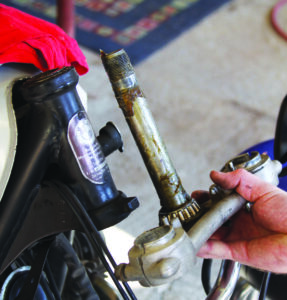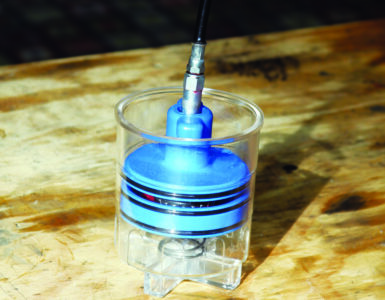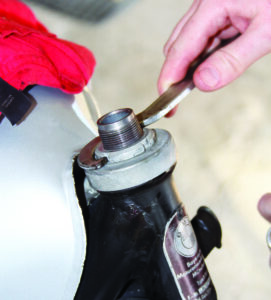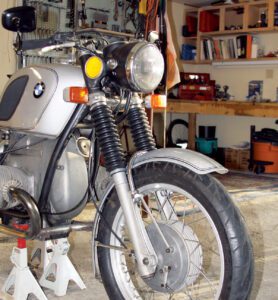Steering head bearings seem to be one of those things we don’t think about until we have to. The problem is, by the time you realize your bike’s steering head bearings need attention — evidenced by notchy, stiff or even loose steering — it’s usually too late to do anything but replace them. And unfortunately, it’s one of the most common problems you’ll find on older bikes. Because it’s a time-intensive job — i.e., expensive — owners often avoid having it done unless it’s absolutely critical; there’s that too late thing again. And because it involves a fairly comprehensive front end tear down, many owners are scared to do the job themselves.
In the Sixties and Seventies, the average bike used ball bearings in the steering head. Simple, cheap and effective, they’re also prone to wear. Although widely used today, back then tapered roller bearings were usually only found in race frames. Effective in high-speed, high load-bearing applications, tapered roller bearings are superior to ball bearings thanks to greatly increased contact area. That’s a fact BMW appreciated when they specified tapered roller bearings for the steering head and swingarm on all “slash” 5 models. Introduced in 1969, the /5 and subsequent /6 and /7 range evolved to incorporate at least eight different engines in multiple body styles. Translation: There are lots of them out there.
And high build quality means a lot of those old Beemers are still on the road today, with many showing impressive miles. Yet even in the hands of a sympathetic owner, most have likely never had the steering head bearings properly serviced.
That was definitely the case with our subject bike, editor Hall’s 1973 BMW R75/5. Hall’s bike has at least 50,000 miles on it (the speedo gave up the ghost long ago), and our tear down suggested we were the first to disassemble its steering head. Predictably, and underscoring BMW’s wisdom in choosing tapered bearings, we found the bearings were in good shape, needing nothing more than a thorough cleaning and regreasing. The bearing races weren’t pitted, scored or showing signs of excessive scalloping; uneven wear evidenced by radial lines in the bearing cup. Scalloping is a fairly common issue with steering head bearings, due to the steering stem’s limited range of motion, and leads to notchy steering and poor handling.
Although it may seem daunting, this is a maintenance project within the scope of the average weekend warrior. The key is budgeting plenty of time. Don’t expect to complete the process in one day. Instead, be satisfied if you get it done over the course of a weekend. And when you’re done, you’ll have the satisfaction of knowing your steering stem has been properly serviced, ready to give you many more years of confident riding. As always, have a good shop manual at your side to help guide you and to supply critical torque specs.

Step 1 First, disconnect the front brake cable and remove the wheel and fender. Next, remove the two bolts securing the headlamp assembly and gently pull it away from the headlamp ears.

Step 2 Remove the four 13mm nuts securing the handlebar and risers to the upper fork bridge; pad the gas tank and rest the handlebar on the tank. Next, remove the fork caps. A cheap and simple strap wrench works great for this.

Step 3 Once the caps are off you can loosen the fork leg nuts. The factory torqued them down to 88-96ft/lb, so we used an air wrench with a 36mm socket to easily break them free.

Step 4 Next, loosen the two fork pinch bolts on the lower fork bridge. Now, unscrew the fork nuts to expose 1/4-inch or so of thread and give the nuts a firm blow with a rubber-faced mallet or dead-blow hammer to break the fork legs loose. Remove the nuts, then the legs.

Step 5 Remove the steering stem center nut and washer, the upper bridge and the headlamp ears. Remove the steering stem adjusting nut as shown, then the dust cover. The stem is now loose.

Step 6 Tap the top of the stem and remove it from the steering head tube. The lower bearing will come with it.

Step 7 The lower bearing is a press fit on the steering stem, the upper is not. Remove the upper bearing and thoroughly clean it, the steering stem and lower bearing with solvent or in a parts washer. Dry the bearings and make sure they’re clean of old grease.

Step 8 Next, clean and inspect the upper and lower bearing races, or cups. Here’s the upper cup. Fortunately, both bearings and races were in good shape, free of any wear marks or damage that would require replacing them.

Step 9 Once everything is clean and dry, it’s time to grease or pack the bearings. We like using a pressure-fed bearing packer like the one here. The bearing is simply sandwiched between two plates. Grease is forced from the inside out through a hollow stem in the packer using a grease gun. Simple and effective.

Step 10 If you don’t have a packer, just do it by hand. Simply put a dollop of grease in your palm and work the bearing down and across the grease, forcing the grease between the rollers and the inner and outer bearing cages.

Step 11 Since the lower bearing is pressed onto the stem, you have to pack it in place. It’s is a little harder to grease than the upper bearing simply because it’s awkward forcing the grease through the bearing. Patience pays dividends here.

Step 12 Once the bearings are packed, give each bearing race a swipe of grease, enough to completely cover the race’s wearing face. We like red extreme pressure grease; it’s easy to see and won’t melt out.

Step 13 Next, slip the steering stem back up into the head tube and slide the upper bearing over the stem and onto its race. Still holding the stem, reinstall the upper bearing dust cover and the upper bearing adjusting nut.

Step 14 Using a C-spanner, tighten the adjusting nut until the stem just tightens up, then loosen the nut slowly until the stem turns freely.

Step 15 Slip the headlamp ears back in place, followed by the upper steering bridge and the steering stem washer and nut. Hand-tighten the nut.

Step 16 Next, reinstall the fork tubes, followed by the fork tube nuts. Brace the forks against the frame downtubes with a short piece of 2×4 between the forks and torque the fork tube nuts to 88-96ft/lb.

Step 17 With the fork tube nuts tight, slip the spanner wrench under the upper bridge and onto the stem adjusting nut. Hold the spanner, and with the forks braced torque the steering stem nut to 88-96ft/lb. Roll the steering stem left and right and check for any binding.

Step 18 Reinstall the fork caps, the handlebar and risers, the headlamp, and the front fender and wheel. Push/pull the fork legs back and forth to check for looseness. Put the bike on the ground, bounce the front end several times to center everything, then tighten the fork tube pinch bolts. That’s it, you’re ready to roll!










